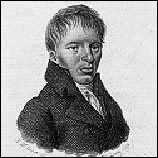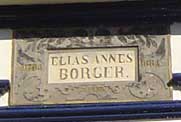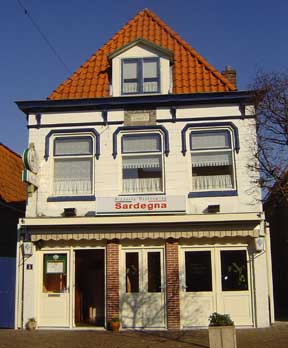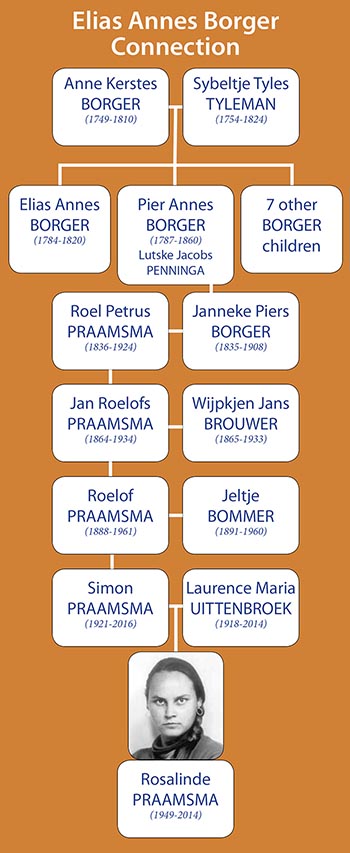Elias Annes Borger (1784-1820)



where Elias and his brother
Pier grew up. Today it is
a pizza restaurant
Read It Fryske Wonder, a PDF book about E. A. Borger and his family connections (Frisian)
Elias Annes Borger Wikipedia (Dutch)
Biographies and Works of Elias Annes Borger (Dutch)
De Roem van het 'Rijntje': Celebrity culture around Elias Annes Borger (PDF article in Dutch)
ELIAS ANNES BORGER was a Dutch poet and professor of theology and literature. His father was a wine merchant and gin distiller in Joure, where Elias studied Latin and Greek. At seventeen he went to Leiden, with limited means, to study for the ministry. He received his doctorate in theology in 1807. His ambitions to become Buitengewoon Hoogleraar (the highest type of professor) were hindered by the French takeover of the Netherlands. After the French left in 1815 he became a general professor of theology. In 1817 he was also appointed professor of history and Greek literature.
In 1814 Borger married Abrahamina van der Meulen, a woman of noble birth (Yonkvrouw) and the sister of an Amsterdam minister. A year later, however, she died in childbirth. In 1819 Elias married (Yonkvrouw) Cornelia Scheltema, also of noble birth, but the following year she too died giving birth, as did the newborn child.
As a result, Borger fell into a deep depression, wanting only to be near his departed loved ones. He expressed his feelings in a book of poetry, Aan den Rhijn in de Lente van het Jaar 1820 ("Ode to the Rhine"). Eight months after the death of his second wife, at the age of 36, Borger also died. He was buried in Katwijk.
(Translated from Dutch by Matthew Block)
From the introduction to the article De Roem van het "Rijntje":
The fame of ‘The Rhine’ - Celebrity culture around Elias Annes Borger
No destiny has provoked so much compassion in the nineteenth century as that of the Frisian scholar and poet Elias Annes Borger (1784-1820). Although nowadays hardly anybody has heard of him, in the nineteenth century he was a well-known poet, though he only published a few poems for special occasions. Particularly famous at the time was the ‘The Rhine, in the spring of the year 1820’, which he wrote after the death of his second wife. Throughout the nineteenth century the poem became a cultural reference point in the Netherlands. Mainly because of this literary work, Borger posthumously received the position of a literary celebrity. This article analyses why the poem remained popular for such a long period of time. Furthermore, it explores the mythologization and ‘fan culture’ around Borger himself. The case of Borger is exemplary of the literary celebrity cult around a poet in the nineteenth century.
A protestant elementary school (the E.A. Borgerschool in Joure) and a scouts group (De Borgergroep) were named in memory of him. Borger's name and book of poetry were immortalized by Hildebrand (Nicolas Beets) in his Camera Obscura. Borger's poetry also appeared in Mrs. Doorbeen's modestly successful essay, De familie Stastok ("The Stastok Family").

ELIAS ANNES BORGER was a Dutch poet and professor of theology and literature. His father was a wine merchant and gin distiller in Joure, where Elias studied Latin and Greek. At seventeen he went to Leiden, with limited means, to study for the ministry. He received his doctorate in theology in 1807. His ambitions to become Buitengewoon Hoogleraar (the highest type of professor) were hindered by the French takeover of the Netherlands. After the French left in 1815 he became a general professor of theology. In 1817 he was also appointed professor of history and Greek literature.
In 1814 Borger married Abrahamina van der Meulen, a woman of noble birth (Yonkvrouw) and the sister of an Amsterdam minister. A year later, however, she died in childbirth. In 1819 Elias married (Yonkvrouw) Cornelia Scheltema, also of noble birth, but the following year she too died giving birth, as did the newborn child.
As a result, Borger fell into a deep depression, wanting only to be near his departed loved ones. He expressed his feelings in a book of poetry, Aan den Rhijn in de Lente van het Jaar 1820 ("Ode to the Rhine"). Eight months after the death of his second wife, at the age of 36, Borger also died. He was buried in Katwijk.
(Translated from Dutch by Matthew Block)
From the introduction to the article De Roem van het "Rijntje":
The fame of ‘The Rhine’ - Celebrity culture around Elias Annes Borger
No destiny has provoked so much compassion in the nineteenth century as that of the Frisian scholar and poet Elias Annes Borger (1784-1820). Although nowadays hardly anybody has heard of him, in the nineteenth century he was a well-known poet, though he only published a few poems for special occasions. Particularly famous at the time was the ‘The Rhine, in the spring of the year 1820’, which he wrote after the death of his second wife. Throughout the nineteenth century the poem became a cultural reference point in the Netherlands. Mainly because of this literary work, Borger posthumously received the position of a literary celebrity. This article analyses why the poem remained popular for such a long period of time. Furthermore, it explores the mythologization and ‘fan culture’ around Borger himself. The case of Borger is exemplary of the literary celebrity cult around a poet in the nineteenth century.
A protestant elementary school (the E.A. Borgerschool in Joure) and a scouts group (De Borgergroep) were named in memory of him. Borger's name and book of poetry were immortalized by Hildebrand (Nicolas Beets) in his Camera Obscura. Borger's poetry also appeared in Mrs. Doorbeen's modestly successful essay, De familie Stastok ("The Stastok Family").
Read It Fryske Wonder, a PDF book about E. A. Borger and his family connections (Frisian)
Elias Annes Borger Wikipedia (Dutch)
Biographies and Works of Elias Annes Borger (Dutch)
De Roem van het 'Rijntje': Celebrity culture around Elias Annes Borger (PDF article in Dutch)
